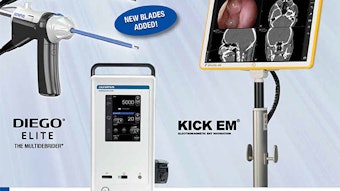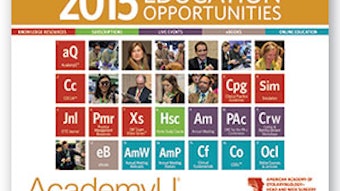KIDS ENT HEALTH MONTHPediatric Chronic Rhinosinusitis in the practiceExpanded from the print edition
The AAO-HNSF published a clinical consensus statement (CCS) on pediatric chronic rhinosinusitis (PCRS) in October 2014, which was designed to promote improved patient care, reduce inappropriate variations in care, and educate and empower clinicians and patients on the optimal management of PCRS.1

The AAO-HNSF published a clinical consensus statement (CCS) on pediatric chronic rhinosinusitis (PCRS) in October 2014, which was designed to promote improved patient care, reduce inappropriate variations in care, and educate and empower clinicians and patients on the optimal management of PCRS.1 How and why was this CCS developed? The AAO-HNSF Guidelines Task Force reviewed and selected PCRS for CCS development as PCRS is a clinical problem frequently encountered by otolaryngologists and is associated with a significant influence on quality of life, but with limited evidence-based research to guide clinical management.2 An expert panel of nine fellowship-trained pediatric otolaryngologists and rhinologists was convened by the AAO-HNSF to create the CCS using a modified Delphi survey method. The latter is a systematic approach to achieving consensus among a panel of topic experts through multiple anonymous surveys.3 Panel members completed an initial qualitative survey on clinical aspects and definition of PCRS followed by two Delphi surveys. The survey results were discussed in detail with all the members of the panel via teleconference to determine which items reached consensus. The panel narrowed the scope of the target population to patients 6 months to 18 years of age without craniofacial syndromes or relative immunodeficiency. The target audience for the statement was otolaryngologists. The findings of this consensus group are stated as opinions or suggestions, not as recommendations. What was the criterion for consensus? The criterion for consensus is summarized in the table below1,4,5 and was established a priori with reference to previous CCSs.4,5
| Strong consensus | Statements achieving a mean score of 8.0 or higher with no outliers* |
| Consensus | Statements achieving a mean score of 7.0 or higher and having no more than 1 outlier* |
| Near consensus | Statements achieving a mean score or 6.50 or higher and having no more than 2 outliers* |
| No consensus | Statements that did not meet the criteria of consensus or near consensus |
| *Outliers were defined as any rating two or more Likert points from the mean.1,4,5 | |
How was PCRS defined?

Adenoidectomy has been shown to decrease the load of nasopharyngeal pathogens associated with PCRS.8,9 Additionally, adenoidectomy is clinically effective in the treatment of children with PCRS based on a meta analysis of eight PCRS studies.10 Given this evidence, there was consensus that adenoidectomy is an appropriate initial surgical intervention in children with CRS from 6 to 12 years of age and strong consensus for patients younger than six. The panel also agreed that adenoidectomy can have a beneficial therapeutic effect independent of endoscopic sinus surgery (ESS). The ability of the adenoid to serve as a bacterial reservoir for the development of PCRS is not related to the size of the adenoid, so lateral plain films are not recommended to evaluate the adenoid in PCRS. Tonsillectomy without adenoidectomy is not useful in the treatment of PCRS. What other surgical therapies may be considered after medical management, adenoidectomy, or both have failed? Endoscopic Sinus Surgery (ESS) has been shown to be a safe and effective therapy for PCRS in patients who have failed maximal medical management11,12 and patients undergoing ESS have more severe disease compared to those managed with antibiotics or adenoidectomy.11 Due to this and other supporting evidence, there was consensus that ESS is effective for managing PCRS and is best performed when medical therapy, adenoidectomy, or both, have not been successful. There was strong consensus that image-guided ESS was helpful for cases where anatomical landmarks may be distorted due to extensive nasal polyps or previous sinonasal surgery and that a CT scan of the paranasal sinuses is indicated prior to ESS. There was not convincing evidence that clinically relevant long-term facial growth is impaired after ESS. Balloon catheter sinuplasty (BCS), performed endoscopically with a balloon over a guide-wire, recently has been developed and used for PCRS management and was reviewed by the panel. No consensus could be reached about the efficacy of BCS for PCRS with the current evidence. In contrast to post-ESS treatment paradigm of CRS in adults, post-operative debridement after ESS for PCRS is not essential for treatment success in children. There was no consensus for turbinoplasty as there have been no clinical studies evaluating its benefit in PCRS.
References
1. Brietzke S, Shin J, et al. Clinical practice guideline: management of sinusitis. Pediatrics. 1001; 1008-798-808.
2. Kay DJ, Rosenfeld RM. Quality of life for children with persistent sinonasal symptoms. Otolaryngol Head Neck Surg. 2003;128:17-26.
3. Dalkey N, Helmer O. An experimental application of the Delphi method to the use of experts. Manage Sci. 1963;9:458-467.
4. Setzen G, Ferguson BJ, Han JK, et al. Clinical consensus statement: appropriate use of computer tomography for paranasal sinus disease. Otolaryngol Head Neck Surg. 2012;147:808-816.
5. Mitchell RB, Hussen HM, Setzen G, et al. Clinical consensus statement: tracheostomy care. Otolaryngol Head Neck Surg. 2013;148:6-20.
6. Pham V, Sykes K, Wei J. Long-term outcome of once daily nasal irrigation for the treatment of pediatric chronic rhinosinusitis. Laryngoscope. 2014;124:1000-1007.
7. Fuicchi A, Sarratud T, Bauygue GR, et al. Topical treatment of rhinosinusitis. Pediatr Allergy Immunol. 2007;18:62-67.
8. Lee D, Rosenfeld RM, Adenoid bacteriology and sinonasal symptoms in children. Otolaryngol Head Neck Surg. 1997;116:301-307.
9. Tallat AM, Baghat Ys, El-Ghazzawy E, et al. Nasopahryngeal bacterial flora before and after adenoidectomy. J Laryngol Otol. 1989;103:372-374.
10. Brietzke SE, Brigger MT. Adenoidectomy outcomes in pediatric rhinosinusitis: a meta-analysis. Int J Pediatr Otorhinologyngol. 2008;72:1541-1545.
11. Makary CA, Ramadan HH. The role of sinus surgery in children. Laryngoscope. 2013;123:1348-1352.
12. Vlastarakos PV, Fetta M, Segas JV, et al. Functional endoscopic sinus surgery improves sinus-related symptoms and quality of life in children with chronic rhinosinusitis: a systematic analysis and meta-analysis of published interventional studies. Clin Pediatr. 2013;52:1091-1097.















